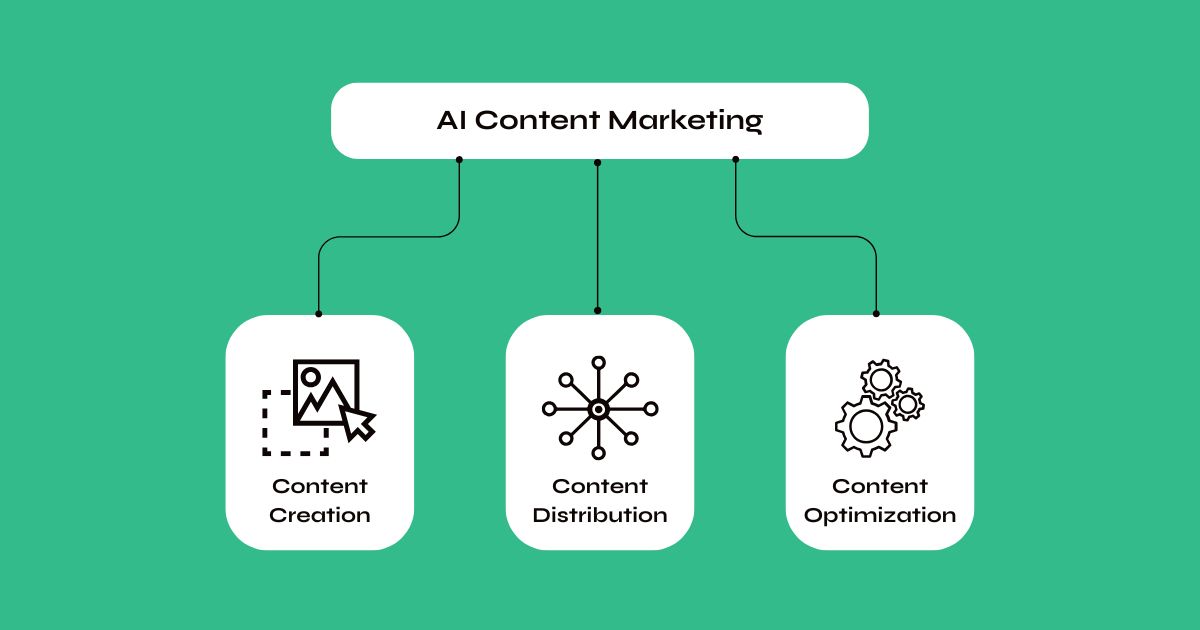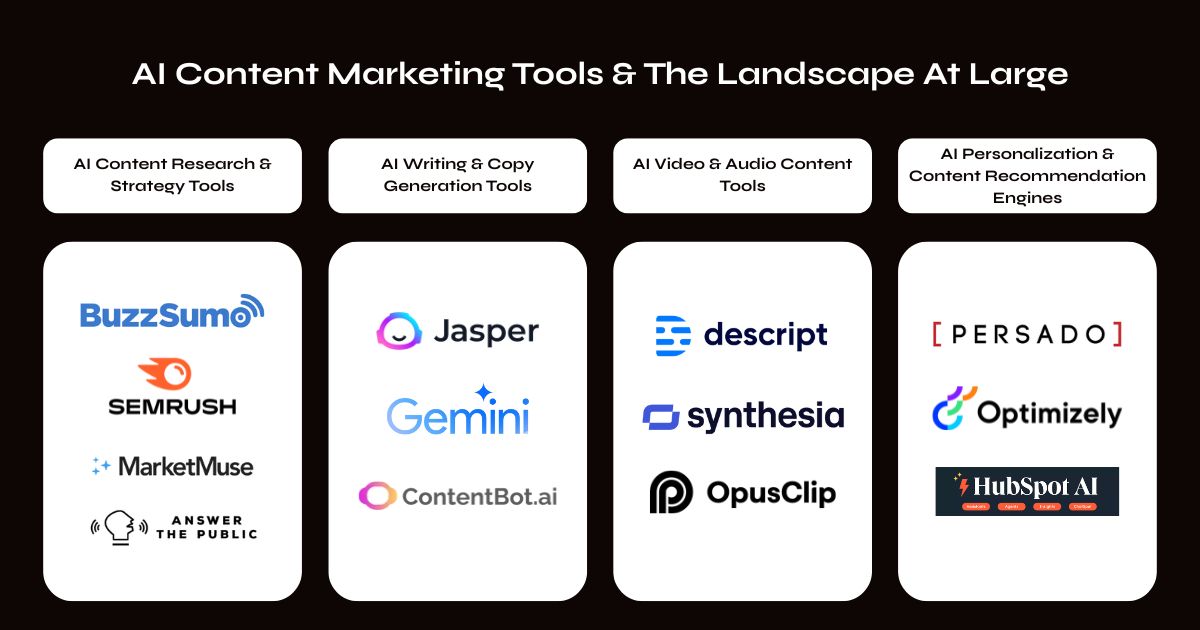
.svg)

Apps like Airbnb, Spotify, and Netflix use AI-powered recommendation systems that learn user preferences and predict what they’ll enjoy next. The same intelligence now powers how marketers personalize content and predict demand.
Now, that same intelligence is reshaping content marketing and transforming the way content marketers perform their jobs, enabling teams to plan, create, and scale personalized content in minutes with the same precision these platforms use to recommend products or shows.
AI content marketing companies use tools to streamline workflows and tailor messaging, using SMART scaling frameworks, i.e., Strategic, Measurable, Agile, Real-time, and Tailored, to systematize workflows and personalize content efficiently.
This approach also raises the visibility bar for brands by optimizing content for AI Overviews and conversational search results, helping brands appear in AI-generated responses.

AI in content marketing plans, creates, organizes, distributes, and analyzes content, enabling teams to work more efficiently while delivering more personalized experiences and actionable insights.
It handles tasks like content generation, SEO optimization, localization, and audience segmentation, so marketers can focus on strategic planning and creative direction.
AI automates routine tasks so teams can focus on strategy, governance, and experimentation. Instead of getting stuck in manual reviews or endless reports, teams can now focus on making smarter decisions, testing new ideas faster, and ensuring better compliance.
Brands are now moving to SMART scale their content to achieve growth. Well, SMART scaling in content marketing is a modern framework that stands for Strategic, Measurable, Agile, Real-time, and Tailored growth.
In simple terms, it’s about doing more of what works, faster and smarter.
AI is an efficient tool for measurable growth that turns content strategies into data-driven systems, delivering measurable ROI across every stage of the marketing funnel.
In simple terms, AI impacts every phase, where Awareness focuses on visibility through SERPs and AI Overviews, Consideration tracks assisted conversions, Decision measures pipeline influence, and Expansion looks at Customer Lifetime Value or CLV (the total revenue a brand can expect from each customer over the long term).
In AI content marketing 2026, content creation is no longer based on guesswork. Predictive analytics and AI workflows for content marketing allow brands to generate content ideas rooted in real-time data. This enables them to stay ahead of the competition, anticipate audience needs, and drive conversion rates.
This data-driven ideation allows for hyper-relevant content that speaks directly to audience intent. But how do we ensure that this content not only drives traffic, but also converts?
Move beyond vanity metrics to track conversion, engagement depth, and CLV using an attribution-enabled stack (e.g., GA4, HubSpot, Dreamdata). Marketers now need to track conversions, engagement velocity, and customer lifetime value (CLV) through AI-powered analytics platforms.
For instance, AI content strategies can be evaluated by how they impact specific metrics:
To effectively measure AI content marketing 2026 ROI, combine AI data tools with traditional metrics to evaluate how content moves prospects through the funnel.
AI is incredibly powerful, but it’s human oversight that keeps content authentic, relevant, and true to your brand voice.
By automating repetitive tasks like topic generation, first drafts, and basic SEO optimization, AI gives creators the space to focus on what really matters, i.e., strategy, refinement, and creativity.
AI can scale your content efforts, but lasting impact comes from balance. That’s where the real ROI lies.
AI Overviews surface context-rich and intent-matched content, not keyword-heavy text. It's no longer just about keyword stuffing, but about optimizing content to satisfy both AI-driven search systems and human readers.
Google’s AI models like BERT and MUM interpret context and user intent, changing how visibility is earned. With AI-powered content strategies, marketers must think beyond keywords to focus on user experience and the ability to answer complex, multi-step queries.
For instance, travel brands optimize for AI-powered voice searches by building conversational FAQs that match how users naturally ask destination-related questions, helping them capture intent-based visibility across Google’s AI Overviews.

When scaling your content strategy, not all AI tools serve the same purpose. Every aspect of content creation, be it research and strategy, writing, SEO optimization, visual and design, social media and distribution, etc, needs different tools and planning to streamline your marketing workflow.
Here are the key types of AI content marketing tools that help brands create smarter, faster, and more impactful content
Before you start writing, doing thorough research and creating a comprehensive strategy is highly essential. A professional AI content marketing agency uses robust AI tools to identify trending topics, analyze competitors, and uncover content gaps that align perfectly with both search intent and audience needs.
The most popular tools include the following:
What it’s used for: content planning, keyword research, competitive analysis, and building topic authority across industries like travel, health, and education.
Once you know what to write, AI can help you actually write it in multiple formats and consistently. These tools generate drafts automatically, from blog posts and ad copy to product descriptions and emails.
The most popular tools include the following:
What it’s used for: producing blog posts, social captions, product descriptions, ad headlines, and SEO-optimized drafts, giving teams more time to focus on strategy and refinement.
Video and audio are increasingly dominating user engagement. AI tools now make it easier to repurpose blogs, webinars, or long-form content into short-form videos, podcasts, and reels that drive higher reach and retention.
From automated editing and voice cloning to script generation and captioning, these tools empower marketers to produce consistent and on-brand multimedia content, helping brands scale storytelling and boost audience connection across multiple platforms.
The most popular tools include the following:
What it’s used for: producing YouTube Shorts, Instagram reels, podcast snippets, and video content that scales effortlessly.
For brands focused on engagement, these tools help deliver personalized experiences to individual users, increasing conversions and retention.
The most popular tools include the following:
What it’s used for: personalizing messaging, A/B testing, audience segmentation, and content recommendations.
An AI content marketing agency primarily utilizes AI to create, share, and enhance its content. It’s not just about automation anymore, but also about smarter content creation.
Various industries are using AI to connect better with their audiences, save time, and deliver experiences that feel more personalized.
Here are the emerging AI trends in content marketing that are reshaping how brands are creating, optimizing, and delivering content to stand out among competitors.
AI personalization has become a must-have for growth-focused brands today. Today, brands can understand user behaviors, preferences, and interests to deliver tailored content to every user precisely.
Instead of sending one-size-fits-all messages, AI helps marketers craft unique experiences for every customer segment, sometimes even for individual users.
By analyzing data such as browsing habits or purchase history, AI can automatically adjust everything from email subject lines to website banners. This ensures customers see what truly matters to them, increasing engagement and conversions. What once took hours of manual effort is now achieved in seconds, and with remarkable precision.
The biggest benefit of AI personalization is ‘relevance.’ When users feel that a brand “gets them,” trust and loyalty naturally follow. AI ensures that the right message reaches the right person at exactly the right moment.
Organizing content around clusters and entity-first strategies improves SEO and authority. AI identifies gaps, suggests related topics, and helps plan comprehensive campaigns.
This reduces the challenge of inconsistent content strategies and improves cross-channel coherence.
AI is transforming content creation from single-format storytelling to multimodal creativity, where text, visuals, video, and even audio come together seamlessly.
Marketers can now produce entire campaigns from a single idea, i.e., a blog post can instantly become a video script, infographic, and social caption, all generated by AI. This shift saves time and cost while maintaining brand consistency.
For instance, fashion or travel brands can generate lifestyle visuals, while tech companies can create explainer graphics or videos, all without needing design or production teams for every piece.
Synthetic media is any content, such as images, audio, video, and text, that is artificially created or manipulated using artificial intelligence (AI) and machine learning.
Using AI, brands can now generate hyper-realistic visuals, avatars, and even virtual influencers, all designed to represent their products or identity without traditional shoots or casting.
This allows endless creativity and personalization. However, authenticity remains crucial, as audiences respond best when brands use synthetic media transparently and responsibly.
Once you are done writing your content, you need to edit it to make it perfect. AI assistants have become indispensable for marketers aiming for high-quality output.
It helps refine grammar, tone, structure, and even visual elements, ensuring every piece aligns with brand voice and audience expectations.
Beyond writing, AI also optimizes images and videos, i.e., cleaning up footage, adjusting lighting, or trimming unnecessary parts automatically. This allows marketing teams to focus more on strategy and storytelling, while AI takes care of the technical perfection.
With the emergence of AI, content can now adapt in real time, changing based on who is viewing it, where they are, or how they interact. AI systems dynamically swap content blocks (headlines, banners, CTAs) based on user context.
AI continuously learns from audience behavior and instantly adjusts what’s displayed, from product suggestions to messaging tone. This kind of live personalization not only keeps content relevant but also makes users feel seen and understood.
Brands that embrace real-time adaptation enjoy higher engagement and conversion rates because their content reacts like a conversation, responsive, timely, and always on point.
Short-form content, especially videos, dominates the Internet today. Platforms like TikTok, Instagram Reels, and YouTube Shorts reward speed, creativity, and storytelling that grabs attention within seconds.
The best approach is to repurpose long-form material into short, snackable clips that highlight key insights or emotions. A single podcast or blog can give dozens of micro-stories for social media.
While short-form content grabs attention, long-form content builds authority. Platforms like YouTube are ideal for in-depth content, like product demos, tutorials, webinars, and storytelling that educate and engage.
Interactive elements like polls, clickable infographics, or immersive videos make long-form content more engaging. When viewers can participate, they remember more and stay longer.
Voice search is changing how people find information online. With smart assistants like Siri and Alexa everywhere, users are now talking to search engines, and that means content needs to sound natural and conversational.
Content marketers should focus on optimizing for question-based and long-tail keywords that reflect how real people speak.
Instead of typing “best budget phone,” users might ask, “What is the best affordable phone with good camera quality?” AI helps decode these nuances and ensure content aligns with spoken intent.
AI accelerates workflows, but human creativity still drives emotional resonance and brand authenticity. However, creating entirely human-generated content requires a lot of manual work, exhaustion, limited tasks done, and timing issues, due to which marketers aren’t able to work on other important stuff like strategy building, campaign analysis, and audience engagement.
On the other hand, creating content that is entirely AI-generated lacks emotional depth, contextual understanding, and the authentic touch that connects with real audiences. It may be fast and efficient, but without human creativity and critical thinking, it risks sounding generic and missing the brand’s true voice.
While AI speeds up workflows, humans remain essential for creativity, strategic thinking, and emotional resonance. AI handles repetitive and data-intensive tasks like content research, outline generation, and SEO optimization, freeing human marketers to focus on storytelling, tone, giving content that emotional touch, and engagement.
Human-in-the-loop editing ensures content is not only efficient but high-quality, trustworthy, and aligned with E-E-A-T signals for AI search. The most effective content strategies blend AI efficiency with human judgment, creating a collaborative ecosystem where strengths are amplified.
And, when brands achieve the balance between AI-generated content and human oversight, they are most likely to achieve enormous growth in their industry.
At ViralGraphs, we specialize in designing AI-first content marketing workflows, helping brands produce up to 3× more content without losing quality, authority, or creativity.
We deliver robust AI content marketing services, integrating research, content creation, optimization, and performance tracking into one smooth system.
As a leading AI content marketing company, ViralGraphs delivers end-to-end AI content marketing services, from topic clustering to AI SEO strategy.
Our services cover everything from topic clustering and AI-generated outlines to SEO optimization and human-guided editing, catering to a wide range of industries.
Whether you want to automate research, generate SEO-ready drafts, or improve performance insights, ViralGraphs blends AI precision with human creativity, making your content smarter, faster, and more impactful.
Also Read- The Psychology of Content: Writing What Your Audience Wants
In 2026, AI has been turning content marketing into a more precise, data-driven, and performance-focused discipline. Brands are now using AI to craft smarter strategies that boost ROI, strengthen audience retention, enhance engagement, and simplify everyday workflows.
The real success, however, lies in balance, where marketers combine AI’s efficiency with human creativity and judgment.
Those who optimize content for both search engines and their users, while maintaining authenticity, trust, and Google’s E-E-A-T principles, are the ones who are truly winning the AI-powered content game.

Ans. SMART scaling is a modern framework that ensures content growth is strategic, measurable, agile, real-time, and tailored. It allows marketers to automate at scale without losing quality, which ensures every content piece aligns with business goals, adapts quickly to trends, and delivers measurable ROI.
Ans. AI enhances search visibility by optimizing content for AI Overviews, conversational queries, and entity-based SEO. Instead of relying on keyword density, AI tools now structure content for context, relationships, and relevance, ensuring it’s discoverable by Google’s AI models like MUM and Gemini, as well as voice search systems.
Ans. True performance lies in conversion depth, engagement velocity, assisted pipeline value, and CLV (Customer Lifetime Value). Combining GA4, HubSpot, and AI attribution tools gives a full-funnel view, tracking how each content asset contributes to awareness, consideration, and revenue impact.
.webp)